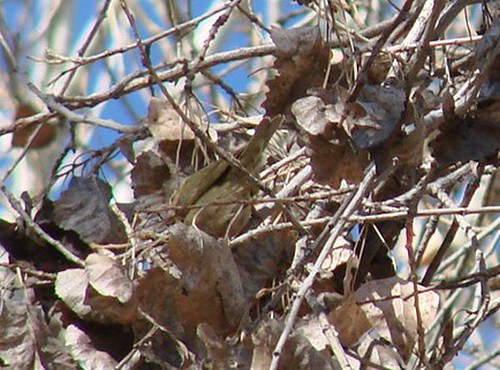tags: Worm-eating Warbler, Helmitheros vermivorus, birds, mystery bird, bird ID quiz
[Mystery bird] Worm-eating Warbler, Helmitheros vermivorus, photographed in Arizona. [I will identify this bird for you tomorrow]
Image: Rick Wright [larger view].
Please name at least one field mark that supports your identification.
Rick Wright, Managing Director of WINGS Birding Tours Worldwide, writes:
Yes, there's a bird in there, and yes, it's identifiable. As a great American poet once observed, all too rarely do the birds we see in the open look / like their pictures in the birdy-books; the views we typically get are of bits of birds, and the more experienced the birder, the fewer bits she needs to identify most species.
Most of this bird is concealed deep in a cluster of dead leaves -- and right there we have enough to identify it with. There are very few dead-leaf specialists in North America, and the hindquarters of only one match what we see protruding from the dried foliage here. The tail is rather short, and the undertail coverts are coarsely marked with dusky terminal crescents. The belly is a dull warm olive, the upperparts the same color but darker and warmer. We can just see the wing to confirm the absence of a bright wingbar.
It's worth learning the undertail patterns of all the wood warblers; Dunn and Garrett [A Field Guide to Warblers of North America (Peterson Field Guides by Jon Dunn and Kimball Garrett] have a fine series of plates with just that purpose in mind.Though we first detected this Worm-eating Warbler by its distinctive buzzy call note, the identification was confirmed by the undertail coverts; only then did it finally reveal the well-known striping of the head.


Haha. I refuse to play. That's just mean. :-)
I stared at it for five minutes and then it jumped out at me - it's a 3-D pic of a yatch sailing on the ocean.
At first glance I thought it might be a vireo because of the head streaking (light superciliary bordered by dark eyeline below and a dark line above). However the darkish spots on the undertail coverts would not fit any of the vireos. After checking Sibley, I think this is a Worm-eating Warbler.
Great bird! I can see from where Chuck is coming with Worm-eating, especially those undertail coverts, but I don't think the supercilium is prominent enough and the tail is too long and too forked.
If I saw it over here (I live in the UK) that supercilium would immediately make me think of Arctic Warbler, but then the overall tone would make me think of Dusky Warbler, but then those undertail coverts, and a photo taken in Arizona ..... ? I don't know what to think!
Looks like an ass to me but must be a cloaca as it's supposed to be a bird...
OK a greenish looking warbler type bird with a forked tail.
Noticeable whitish supercilium.
I'm thinking Swainson's warbler.
This is a great discussion. But I don't think the bird's head is visible!
I'm going in a different direction. How about a female Tanager. The forked tail, lack of any discernable pattern on the wings. No streaking on the sides. Perhaps a female Hepatic Tanager might be hanging around when the leaves are dead in Arizona. It's either that or the 3D Yacht that Ian saw.
That's cruel. A leaf (when you blow it up enough) that even when blown up, on the resolution provided still looks like a supercilium, eye and even bill!
Perception is a weird thing. I've stopped for a closer look at lots of leaves, sticks, power-line insulators, etc., but I had no idea what supercilium three people were seeing. Now that I know for sure the head isn't there, I can finally see what they saw.
Oh, the bird? Probably Passeriformes.
Another sours of good infomion on warblers is Dunn and Garrett's book on on warblers, especially good are the depiction of undetail coverts. Also, in either Dunn or NatGeo (I'm away from home right now) it says that the Worm-eating Warbler forages almost exclusively in dead leaves and this bird is definitely in dead leaves.
Spelling corrections - source, and information, not sours and informion. Sorry
Oh, yes, I see it now. That is definitely a bird's butt amongst some dead leaves!
Orange-crowned Warbler.
The olive-drab, late migrating winter sculker. The overall coloring seems right. And the length of the tail and primary projection is also about right. But the heavily notched tail is worrisome. I don't think the Worm-eating Warbler has as this much overall green cast and I've only seen Worm-eating Warblers eating in the dead leaves on the ground.
Not a lot of detail here so I'll just go with my first impression.
By the way, this is the kind of challenge that makes it interesting.